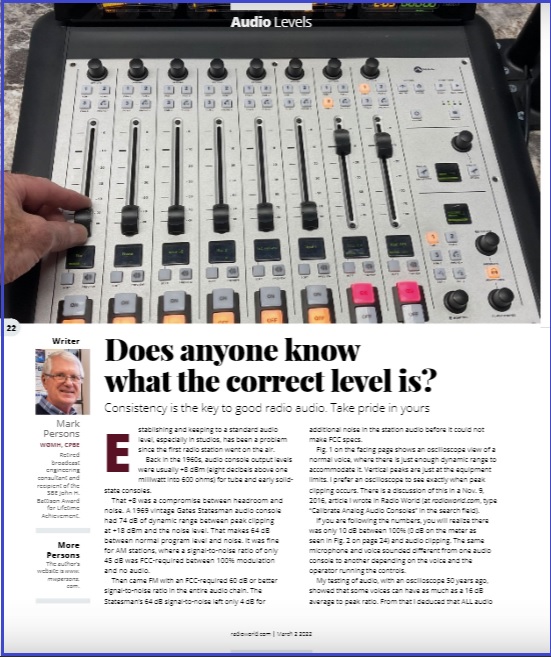The following letters were in response to Mark Persons’ article “Does Anyone Know What the Correct Level Is?”
Consistent Audio Levels
Mark Persons’ article about keeping consistent audio levels hit it on the head.

We had the same problem in TV with our field crews as digital gear came in. Many thought the peak level was –18 and that you couldn’t peak over that, so they undershot. Management wanted to know why the noise was so bad on field recordings, and editors had to crank the levels; after all it’s digital. Problems were due to no training on the new gear and unfamiliarity with the digital domain.
I was asked to train operators in proper levels. Unfortunately the cameras had a black scale on audio levels; it was hard for operators to see the full digital scale in bright light, adding to the confusion. I think it would have been less of a problem if we’d had a color display, but the cam operators got it.
The gear we used for training editors fortunately had tricolor displays. My mnemonic device was “If it’s green, you’re lean; mellow is yellow; and red you’re dead.” That seemed to stick with people and corrected many problems.
I used an analogy because of my experience with aviation visual approach slope indicator (VASI) lights on the runway: “Red over white, you’re alright” and “Red over red, you’re dead.”
Thanks Mark for a great explanation of what goes on with the “new/old” audio levels.
— Lou Sabatini, W9LRS
Once Clipped, Always Clipped
I thoroughly enjoyed Mark Persons’ article on audio levels in the studio. I just wish someone would write something like that for the recording industry.
As a field engineer for two major Christian music radio networks, I go to great lengths to make sure my stations sound the best they can, and it’s super frustrating to have some incompetent recording and/or mastering engineers clip the daylights out of the audio. They say it sounds OK for the people listening to an MP3 on cheap earbuds. Well, not all of us are listening that way!
The L.A. guys still tend to do it right; the worst stuff comes out of Nashville.
Like Mark said, once it’s clipped, it’s permanently damaged. It seems like the majority of what we get is that way now. I know most of my fellow field engineers feel this way.
— Scott Todd
[Check Out More Letters at Radio World’s Reader’s Forum Section]
Pretty Lights
Hello, and thank you for Radio World. I enjoy keeping up with the new tech and techniques in radio today.
I just read Mark’s article on studio levels. It brought back so many memories, especially from my college radio station. It seemed like they had 17 different standards for the same measurements. But we’ve all encountered this. Add in that most of the studio equipment was older than I was, and it was a fun time for everyone.
One summer, a fellow engineer and I did a major sweep and test of every piece of gear, right down to adjusting the tensions on the reel to reel decks. We also did a major facelift of the studios. (It’s amazing what a can of spray paint and some scrap sheet acrylic can do.)
Everything was clean, working and running +4 dBm. We also updated the old Vu meters to LED readouts.
Later, when we were back in full operation, we heard some bad distortion on the office monitors. When we went to the air studio to find out what was happening, we saw that the DJ had the fader cranked up to 9. When I reached out and turned it down, the conversation was short, sweet, and frustrating:
Me: Why are you playing that so hot?
DJ: So I can see the pretty lights you guys installed.
That’s one studio level that you just can’t adjust with a reference tape and a screwdriver.
— Archie Stulc
Radio World invites industry-oriented commentaries and responses. Send to Radio World.











